 I'm updating the next edition of Lonely Planet's Laos guide, and have based myself in Vientiane, that country's capital. I've rented a colonial-era shophouse strategically located within walking distance from an excellent Lao restaurant, a traditional Lao sauna, the city's evening market, two very good French bakeries and the tam maak hung stall illustrated above. I'll most likely in Laos for the better part of the next three months, and you can look forward to dispatches on the places mentioned above, and more.
I'm updating the next edition of Lonely Planet's Laos guide, and have based myself in Vientiane, that country's capital. I've rented a colonial-era shophouse strategically located within walking distance from an excellent Lao restaurant, a traditional Lao sauna, the city's evening market, two very good French bakeries and the tam maak hung stall illustrated above. I'll most likely in Laos for the better part of the next three months, and you can look forward to dispatches on the places mentioned above, and more.
blog
Khua kai at Phlapphlachai
 After more than a decade in Bangkok, I’m still stumbling upon new entirely new dishes and places to eat. My latest discovery is an obscure intersection near Bangkok’s Chinatown that is home to several restaurants serving kuaytiaw khua kai, a fried noodle dish that’s also a relatively recent discovery of mine. The dish, which consists of wide rice noodles fried with chicken breast and pickled squid and served over lettuce, I first encountered at this alleyway vendor in Chinatown. He has been my go-to guy for the dish, and I don’t believe I’ve tried it anywhere else.
After more than a decade in Bangkok, I’m still stumbling upon new entirely new dishes and places to eat. My latest discovery is an obscure intersection near Bangkok’s Chinatown that is home to several restaurants serving kuaytiaw khua kai, a fried noodle dish that’s also a relatively recent discovery of mine. The dish, which consists of wide rice noodles fried with chicken breast and pickled squid and served over lettuce, I first encountered at this alleyway vendor in Chinatown. He has been my go-to guy for the dish, and I don’t believe I’ve tried it anywhere else.
Until now.
For some reason, the Phlapphlachai intersection is home to at least five restaurants and street stalls serving kuaytiaw khua kai. Visiting the area over the course of two nights, I did three of these restaurants.
Located right at the intersection, Nong Stamp:

Does the standard kuaytiaw khua khai as described above, but we opted for the slightly unusual seafood version of the dish (pictured at the top of this post), which includes fresh shrimp and squid. Smokey and crispy, it was a very good interpretation of the dish, although I found it a bit under seasoned, and missed the combination of chicken and egg. (Nong Stamp also has an interesting menu of other non-kuaytiaw khua kai dishes, so you can expect to hear more from me about this restaurant in the near future.)
Just up the road, Nong Ann:

does several versions of the dish, and very little else, other than tasty fruit shakes (try the watermelon). We opted for the traditional, chicken with pickled squid:

Although good by most standards, particularly in terms of seasoning, it wasn’t as satisfying as Stamp’s, lacking the smokiness and slight crispiness I associate with kuaytiaw khua kai.
Located in an alleyway behind Nong Ann, Nay Hong immediately won me over its huge crowds:

ridiculously old-school and photogenic setting:

and crusty old cook:

who cooks the dish, over coals, almost pancake style, allowing the messy mixture of chicken, eggs and noodles to crisp on one side before flipping the whole lot over en masse. This provides the dish with a crispy texture and lots of tasty singed bits:

Smokey and well seasoned, and it’s the perfect kuaytiaw khua kai.
Kuaytiaw Khua Kai vendors Phlapphlachai Intersection, Bangkok Dinner
View Thai Eats in a larger map
Khrua Paking
 Northern-style Chinese food is relatively hard to find here in Bangkok. This shouldn't come as a surprise, as most Chinese-Thais trace their roots back to southern China, and anyway, heavy wheat-based food isn't generally the first thing people reach for when they're sweating from every pore. So stumbling upon Khrua Paking (Beijing Kitchen) while actually in search of another restaurant, was a spot of good luck.
Northern-style Chinese food is relatively hard to find here in Bangkok. This shouldn't come as a surprise, as most Chinese-Thais trace their roots back to southern China, and anyway, heavy wheat-based food isn't generally the first thing people reach for when they're sweating from every pore. So stumbling upon Khrua Paking (Beijing Kitchen) while actually in search of another restaurant, was a spot of good luck.
The restaurant appears relatively new, is a literal hole-in-the-wall, located in a neighbourhood I imagine only Chulalongkorn University students are familiar with, and serves most of the northern-style standards. The dish above, which was recommended, combined tasty hand-pulled noodles with a minced pork topping and slices of cucumber. The pork topping had an intensely meaty flavour and an almost dried texture.
The restaurant also pushed their flash-fried greens:

which, seasoned with garlic, a pinch of salt and a few drops of soy sauce, and just barely cooked, were very Chinese and very good. It's funny how such a simple dish can be so hard to find in Bangkok (the Thai equivalent uses different greens and seasonings and a lot more oil).
I'm usually not a fan of Chinese-style soups that combine egg, corn starch and vinegar, but the restaurant's Sichuan soup:

was actually pretty good.
There was a salad of Sichuan-style preserved greens:

which was a bit heavy on the sliced leeks, but crunchy and satisfying.
And fried dumplings:

although to be honest I thought I was ordering something similar to the stuffed breads described in this post. These were good, if a bit greasy, and like all the dishes here, were fully flavoured, made and served with confidence, and exceptionally cheap. Khrua Paking is definitely worth checking out if you're looking for something a bit different. And yes, it's air-conditioned.
Khrua Paking 229 Soi Chula 11, Bangkok 02 611 9281 10am-10pm
View Thai Eats in a larger map
Nang Loeng Market's khanom beuang
 Located near Bangkok's historic Nang Loeng Market is a narrow alley where you'll find two slightly different dishes, united in their use of the same name, a crispy shell and a predominately sweet flavour:
Located near Bangkok's historic Nang Loeng Market is a narrow alley where you'll find two slightly different dishes, united in their use of the same name, a crispy shell and a predominately sweet flavour:

The first vendor, Ya Sam, makes the rarer form of khanom beuang (pictured at the top of this post), a crispy egg- and flour-based omelet filled with bean sprouts, tofu, coriander and a savoury/spicy mixture of coconut meat, shrimp, black pepper and coriander root. The dish is served with a sweet/sour dipping sauce that combines sliced cucumbers, chili, ginger and shallots. Frankly, I find this type of khanom beuang a bit too sweet, but this is a personal preference, and in fact think these flavours are probably representative of authentic old-school Bangkok-style food.
Virtually across from this stall there's also a vendor of the more ubiquitous form of khanom beuang:

Lung Noy still makes these crispy taco-like snacks the traditional way, with a bean-based batter and two fillings, sweet, which combines dried fruit and sweet duck egg yolk strands, and savoury, which has a spicy shrimp mixture similar to the one mentioned above.
An ideal one-stop meal destination for those who appreciate linguistic redundancy, sweet flavours and a bit of crunch.
Khanom beuang vendors Soi 4, Thanon Nakhon Sawan, Bangkok Lunchtime
View Thai Eats in a larger map
Where to eat in Bangkok 2010
 I often get emails from people en route to Bangkok asking me to recommend the best places in town to eat. I reply to these when I can, but sometimes the volume of mail can get overwhelming, so back in 2006 I put together a blog post to address this problem. I recently stumbled upon the post, which by now is somewhat out of date, and thought it was high time to provide an updated version.
I often get emails from people en route to Bangkok asking me to recommend the best places in town to eat. I reply to these when I can, but sometimes the volume of mail can get overwhelming, so back in 2006 I put together a blog post to address this problem. I recently stumbled upon the post, which by now is somewhat out of date, and thought it was high time to provide an updated version.
Again, this isn't a definitive list of Bangkok's best restaurants, but rather a general guide aimed at first-time visitors trying to make sense of the city's food offerings.
If you're fresh off the plane on your first trip to Thailand, I still feel that the best place to dip your toe in the water of Thai food is a mall food court. They're clean and cheap, the menus are written in English, you have a wide range of choices, and actually, the food can be pretty good. My favorite food court is probably the one on the sixth floor of Mah Boon Krong (also known as MBK). There you’ll find most of the Thai standards, a huge variety of Thai-Chinese food, and there's even a stall selling Thai-Muslim food and a good vegetarian stall. The food court in the basement of Siam Paragon is a bit more expensive and mostly Chinese-Thai, but is also a decent and convenient choice. If you're feeling a bit more adventurous, you could also try one of the slightly more downmarket food centres such as the two huge food halls at the end of Silom Soi 10 that serve the area's hungry office staff, or Food Plus, the alleyway between Soi 3 and Soi 4 at Siam Square.
At this point you’ve found a dish or two that you like and are likely at least somewhat familiar with the flavours of Thai food. Assuming you're on vacation, you'll want to hit up at least one upscale Thai restaurant. Unfortunately I haven't actually been to many upscale Thai restaurants in the years since I wrote the first version of this post. The only one I'm really familiar with right now is Bo.lan, which despite having eaten there at least five times, I've yet to blog about (they're open for lunch on weekends now, so I'll get around to it soon). The restaurant is owned and run by two former chefs of David Thompson's London restaurant Nahm, and their dedication to great ingredients and obscure old-school Thai recipes combine to make it a worthwhile investment. Another alternative, although it's upscale in the Thai sense, is the delightfully old-school Sorndaeng.
Once you’ve downed a few plates of food court nosh and have consumed the requisite nice Thai meal, I reckon you’re ready for the next step in Thai dining: a good food neighborhood. In my opinion, this is the highest level of Thai dining, and a good food 'hood will have mix of good stalls, specialist shops and a good all-around restaurant or two. The downsides to this are that you'll need a bit of experience to recognise what's on offer, and language can be a barrier. If you're game for a bit of adventure, one of Bangkok's best is the area around Thanon Tanao:
View Thai Eats in a larger map
a strip of road teeming with legendary Thai eats, including several specialised vendors including my favourite khanom beuang the excellent Paa Thong Ko Sawoey, and a few good all-around restaurants such as Chote Chitr, Poj Spa Kar, Kim Leng and a couple blocks away, Krua Apsorn.
At this point you'll have sampled a cross section of Thai cuisine and you're most likely ready for the final step: Thai street food. These affairs are generally only open at night, are not the cleanest restaurants you’ll ever see, very little English is spoken and are located in inconvenient parts of town. But the food can be outstanding and the experience fun. In this regard, I wholeheartedly endorse Bangkok's Chinatown:
View Thai Eats in a larger map
Simply walk down Thanon Yaowarat, avoid the annoying touts at touristy seafood restaurants, and pay attention as you reach the intersection at Soi 6. There you will find virtually every form of Chinese-influenced Thai street food. In this area I particularly like the egg dishes at Nay Mong, the kuaytiaw khua kai vendor and Nay Uan's kuay jap.
Breakfast in KL
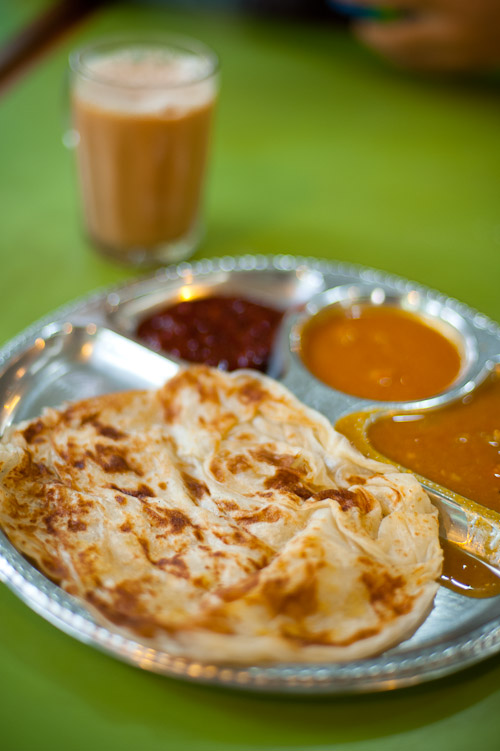 Combine roti canai, a type of fried flatbread served with a spicy dhal-based dipping sauce, teh halia, sweet ginger tea, and throw in a copy of theSun with fresh dirt about Anwar's sodomy trial and you have a thoroughly delicious and entertaining breakfast one could only find in Malaysia.
Combine roti canai, a type of fried flatbread served with a spicy dhal-based dipping sauce, teh halia, sweet ginger tea, and throw in a copy of theSun with fresh dirt about Anwar's sodomy trial and you have a thoroughly delicious and entertaining breakfast one could only find in Malaysia.
Sek Yuen
 Last week I found myself in Kuala Lumpur, Malaysia, attending Joe McNally's photography workshops. Thus, not only was I in photo geek heaven, but this being KL, I was likewise also in Asian food heaven, and with the guidance of EatingAsia and Jarrett, had a string of virtually faultless meals, ranging in scope from vegetarian southern Indian to porky Chinese.
Last week I found myself in Kuala Lumpur, Malaysia, attending Joe McNally's photography workshops. Thus, not only was I in photo geek heaven, but this being KL, I was likewise also in Asian food heaven, and with the guidance of EatingAsia and Jarrett, had a string of virtually faultless meals, ranging in scope from vegetarian southern Indian to porky Chinese.
But the meal that stands out, and which was recommended by both of the above, was Sek Yuen. This longstanding restaurant is unabashedly old-school, and was allegedly a popular destination for wedding receptions in the past:

But it isn't all about appearances here. The kai lan with crispy pork belly:
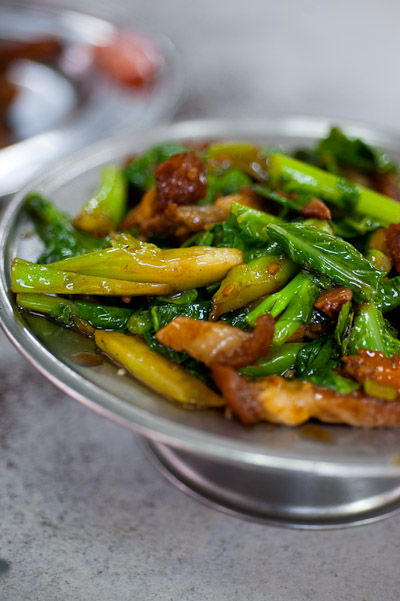
is quite possibly the tastiest Chinese-style flash-fried veggie dish I've yet to encounter: smokey (they still cook everything over wood here), crispy/crunchy, meaty and garlicky; the only thing it could possibly use was a bit of chili.
The restaurant's famous roast duck (virtually every table had an order of this):
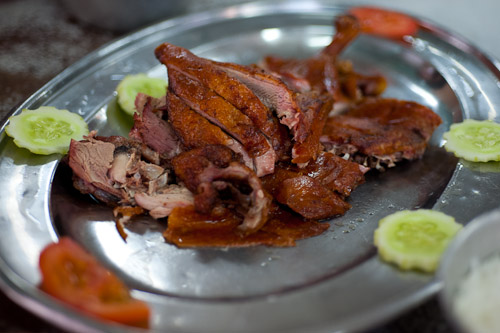
although not entirely photogenic and slightly dry, was immensely satisfying, the crispy skin holding the subtle flavour of a complex dried spice rub.
There was steamed pork ribs:
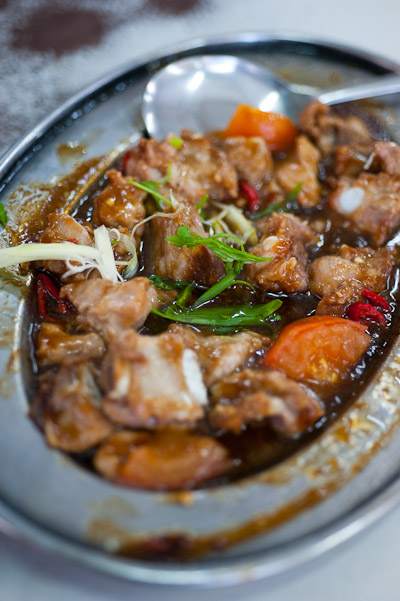
served with an oyster sauce- and sesame oil-heavy sauce, making the dish somehow seem even meatier than its already meaty appearance.
An attempt to order what in Thailand is known as kuy chai phat tao huu (garlic chives fried with tofu) instead got us gourd fried with egg (Thai-accented Teochew Chinese doesn't get me as far as I assumed), but communications problems aside, I found the staff here lovely:
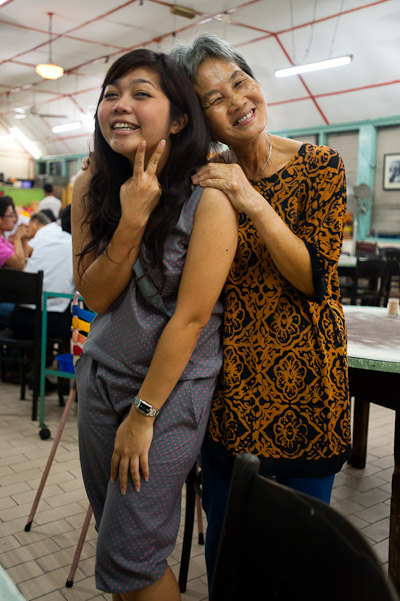
Lovely enough, in fact, for a re-run. Visiting again the very next evening, I had yusheng:
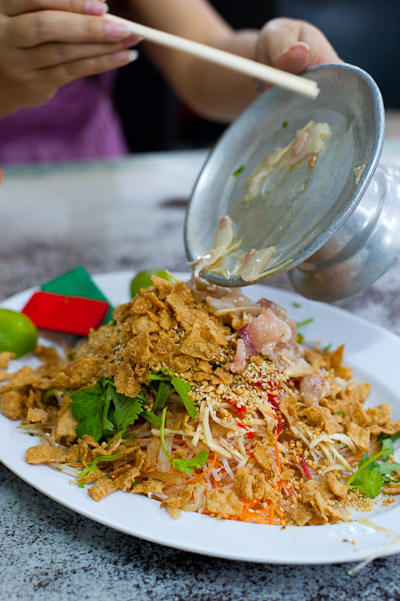
a raw fish 'salad' that has apparently become associated with Chinese New Year in Singapore and Malaysia. The dish is only available for two weeks at Sek Yuen, and with disparate ingredients including (but not limited to) ginger, pomelo, sesame oil, cinnamon and jellyfish, was a fascinating combination of virtually every texture and flavour imaginable.
Anybody visiting Kuala Lumpur is well-advised to check out EatingAsia's Top Ten Eats in KL (I made it to nearly half of them).
Sek Yuen Restoran 313-315 Jalan Pudu, Kuala Lumpur 03 9222 9457 Lunch & dinner, Tues-Sun
View Thai Eats in a larger map
Snapshots from Mae Hong Son: For sale
 20 rai of land, located just outside Mae Hong Song city, 3 million baht (approximately US$90,000).
20 rai of land, located just outside Mae Hong Song city, 3 million baht (approximately US$90,000).
Sigh...
Snapshots from Mae Hong Son: Extreme Engrish
 It's been a while since I've checked out Engrish.com, but this sign, at the Pha Bong Hotsprings, 12km outside Mae Hong Son, reminded me of the site. In case the text above is too small to read, it says:
It's been a while since I've checked out Engrish.com, but this sign, at the Pha Bong Hotsprings, 12km outside Mae Hong Son, reminded me of the site. In case the text above is too small to read, it says:
prohibit dip foot appeareds a pond
prohibit down water uncle in a pond
prohibit sit take a bath on pond edge
I was bathing here one morning (a wonderful experience) and apparently violated the last rule, as a man walked over to tell me that I shouldn't sit on the elevated edge of the hot spring. According to him, people were complaining it 'didn't look nice' and that the 'dirty water' from my body would go back into the hot spring (a vast pond of boiling water, I remind you) and make it unclean.

I obliged, but was also reminded of how utterly important appearances are in Thailand, often taking precedence over reality, common sense and proper grammar.
Snapshots from Mae Hong Son: Khao puk ngaa
 Khao puk ngaa, pounded sticky rice coated with ground sesame, a traditional sweet, Mae Hong Son
Khao puk ngaa, pounded sticky rice coated with ground sesame, a traditional sweet, Mae Hong Son
Snapshots from Mae Hong Son: Still life
 Gourds for sale at Mae Hong Son's morning market
Gourds for sale at Mae Hong Son's morning market
Hotshoe in KL
 Last week I attended two of Joe McNally's photography workshops in Kuala Lumpur, Malaysia, The Hot Shoe Diaries and Let There Be Light. I learned heaps and got the chance to use lots of previously unfamiliar lighting equipment, although not always successfully, as illustrated above. But regardless of our success, Joe was an enthusiastic, fun and inspiring teacher:
Last week I attended two of Joe McNally's photography workshops in Kuala Lumpur, Malaysia, The Hot Shoe Diaries and Let There Be Light. I learned heaps and got the chance to use lots of previously unfamiliar lighting equipment, although not always successfully, as illustrated above. But regardless of our success, Joe was an enthusiastic, fun and inspiring teacher:

and in addition to two of his excellent books and some cool new Lastolite gear, I took home several techniques and ideas that I hope to use soon. If Joe is ever in your part of the world, I'd highly recommend investing in his workshops. Failing that, do check out his books The Moment It Clicks and The Hot Shoe Diaries, both of which are fun and pretty enough to grace the coffee table, but informative enough for the photo geek.
(For any photo geeks out there, the shot above was taken with my D700 and a 70-200 f/2.8 with two barn-doored SB900s providing the backlights and to camera left, an SB800 shot through a 30" Ezybox Softbox diffused additionally through a TriGrip, all of this, believe it or not, in TTL mode.)
Snapshots from Mae Hong Son: Party animals
 Handing out khao ya kuu on the streets of Mork Jampae, Mae Hong Son
Handing out khao ya kuu on the streets of Mork Jampae, Mae Hong Son
My stay in Mae Hong Son coincided yet again with khao ya koo, a Shan celebration in which caravans of partying locals hand out packets of sweetened sticky rice to anybody and everybody in the name of making merit. It's heaps of fun and reminded me of the fact that I seem to bump into some sort of festival or another virtually every time I'm in Mae Hong Son.
Snapshots from Mae Hong Son: Village Life
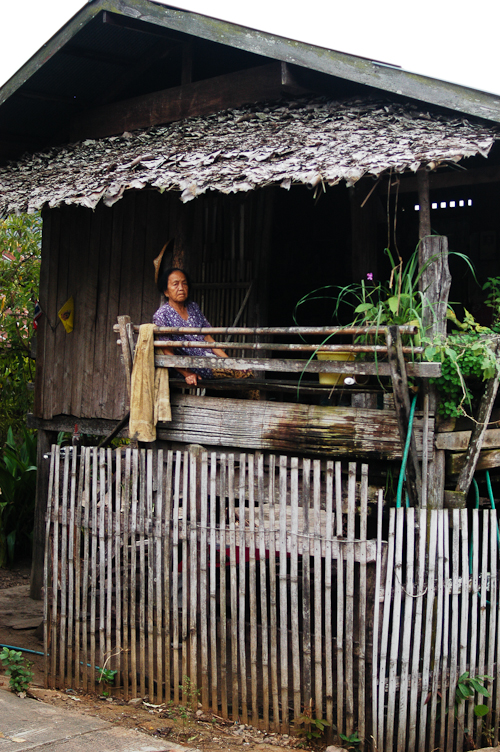 Typical Thai Yai house and resident, Mork Jampae, Mae Hong Son
Typical Thai Yai house and resident, Mork Jampae, Mae Hong Son
Sometimes Mae Hong Son can appear as if it's stuck in a time warp. A considerable amount of the people here still speak the local dialect, eat the local cuisine and dress traditionally, many even wearing the kup tai (a conical hat). Likewise, most villages here appear to have changed equally little in decades. This is particularly the case with Thai Yai villages such as Mork Jampae, shown above, located about 12km from Mae Hong Son. The vast majority of the houses in Mork Jampae are made from wood and many still feature roofs made from bai tong tueng, a type of local leaf. And as is the case in other Thai Yai villages across the province, the houses are almost always incredibly tidy with a wooden or bamboo fence out front, upon which flowers and/or vegetables are grown. The only obvious concession to modernity is that instead of the tho, a clay vessel of water traditionally situated in front of the house for passers by, most houses now have modern water filters with a tap.
Snapshots from Mae Hong Son: Lung Long
 Lung Long, Mork Jampae, Mae Hong Son
Lung Long, Mork Jampae, Mae Hong Son
Lung Long is one of the few remaining people in Mae Hong Son who is skilled in the Shan art of doing metal fretwork. Such fretwork decorates the rooflines of the province's largely Burmese-style Buddhist temples and was previously made by hand from zinc, but now stainless steel or aluminum is used. Lung Long is mostly retired these days, but will occasionally do work to order, such as the peacocks above that I commissioned. If you want a special souvenir from Mae Hong Son and are willing to go to Mork Jampae (a Thai Yai village about 12km from Mae Hong Son), give him a call at 084 367 3618.
Snapshots from Mae Hong Son: Breakfast
 Locals eating breakfast at Mae Hong Son's morning market
Locals eating breakfast at Mae Hong Son's morning market
The breakfast choices offered at Mae Hong Song's morning market are truly unlike anywhere else in Thailand. Although most tourists from Bangkok head directly for the jok (rice porridge) stall, there are some very cool local dishes including delicious deep-fried goodies called khang pong, the local version of khanom jeen nam ngiaw, a watery pork- and tomato-based soup served over rice noodles, and thua oon, a weird but tasty Burmese noodle dish in a thick gram bean gravy.
Snapshots from Mae Hong Son: The Walk
 A rice field outside Mae Lana, Mae Hong Son, northern Thailand
A rice field outside Mae Lana, Mae Hong Son, northern Thailand
A few pics of my walk from Ban Mae Lana to Ban Tham Lot.
 Eating breakfast at a hill tribe village outside Mae Lana
Eating breakfast at a hill tribe village outside Mae Lana
 Piglets at a hill tribe village outside Mae Lana
Piglets at a hill tribe village outside Mae Lana
 Limestone mountains outside Ban Tham Lot
Limestone mountains outside Ban Tham Lot
The walk followed, more or less, this route:
View Thai Eats in a larger map
Snapshots from Mae Hong Son: Khao Kan Jin
 I've previously blogged on khao kan jin, rice steamed with blood and bits of meat -- a Shan/Thai Yai dish that's popular here in Mae Hong Son. After eating at the previously mentioned stall for years, I finally found another vendor, hidden in a side street and located roughly across from the TOT (Telephone Organization of Thailand) office. Drizzled with garlic oil and served with sprigs of cilantro, raw garlic cloves and deep-fried dried chilies, there isn't much to distinguish the khao kan jin (pictured above) here from my old standby. Both stalls are open at roughly the same time (3-6pm) and both serve khanom jeen nam ngiaw and deep-fried pork rinds. If anything, I'd say that the khao kan jin here is slightly less rich, and the stall also does a variation of the dish that has not been steamed and thus contains raw blood -- the result being a rather intimidating bright pink ball of rice.
I've previously blogged on khao kan jin, rice steamed with blood and bits of meat -- a Shan/Thai Yai dish that's popular here in Mae Hong Son. After eating at the previously mentioned stall for years, I finally found another vendor, hidden in a side street and located roughly across from the TOT (Telephone Organization of Thailand) office. Drizzled with garlic oil and served with sprigs of cilantro, raw garlic cloves and deep-fried dried chilies, there isn't much to distinguish the khao kan jin (pictured above) here from my old standby. Both stalls are open at roughly the same time (3-6pm) and both serve khanom jeen nam ngiaw and deep-fried pork rinds. If anything, I'd say that the khao kan jin here is slightly less rich, and the stall also does a variation of the dish that has not been steamed and thus contains raw blood -- the result being a rather intimidating bright pink ball of rice.
Khao kan jin Located roughly across from TOT office, Mae Hong Son 3-6pm
View Thai Eats in a larger map
Snapshots from Mae Hong Son: Mae Lana
 I told you it was pretty.
I told you it was pretty.
The above is Mae Lana, the Shan village mentioned in my previous post. Mae Lana is located about 50km northeast of Mae Hong Son in a steep picturesque valley and is famous for Tham Mae Lana, a 12km-long cave.
Taking a break from the hectic metropolis that is Mae Hong Son, I decided to drive up to Mae Lana and stayed a night at Garden Home, the village's only guest house. Waking up early the next morning, I went on a 20km walk that wound through mountain scenery:

and the occasional hilltribe village before terminating at Ban Tham Lot, another village near a cave.
Snapshots from Mae Hong Son: Chicken
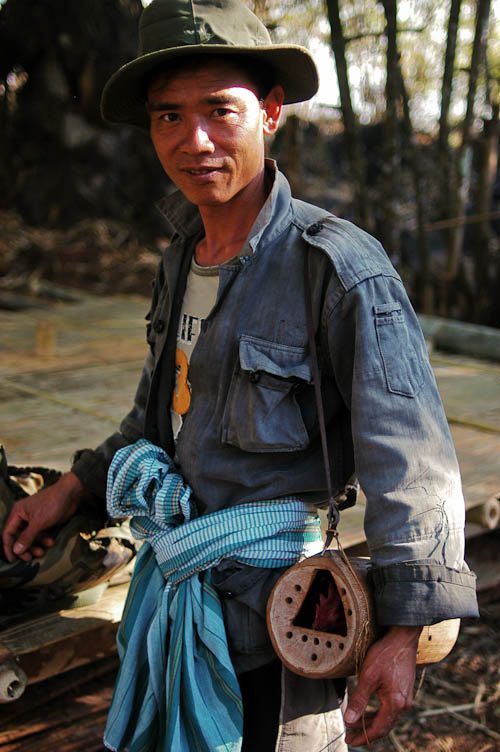 To regular readers, it will come as no surprise that, yet again, I find myself up in Mae Hong Son, northern Thailand. This time I'm only up here for 10 days, and am already doing a fair bit of writing, so I'd prefer to keep my blogging to mostly image-based, marginally food-related posts. A caveat: I'm shooting with my old D100, a single 35mm f/2 and am editing the images on a laptop, so the images won't be amazing, but to be honest, I find that the 400ISO JPEGs from this camera have an attractive old-school film-like quality.
To regular readers, it will come as no surprise that, yet again, I find myself up in Mae Hong Son, northern Thailand. This time I'm only up here for 10 days, and am already doing a fair bit of writing, so I'd prefer to keep my blogging to mostly image-based, marginally food-related posts. A caveat: I'm shooting with my old D100, a single 35mm f/2 and am editing the images on a laptop, so the images won't be amazing, but to be honest, I find that the 400ISO JPEGs from this camera have an attractive old-school film-like quality.
I came across the guy above just outside Ban Mae Lana, possibly the most attractive rural village anywhere in the country. He made for a nice portrait, but initially I was drawn to his 'luggage':

a chicken container carved out of a length of bamboo, complete with a window and airholes! He explained that he takes the rooster into the woods, ties it to something and encourages it to call. This apparently attracts any 'wild chickens' (kai paa), which he then shoots. Unfortunately this particular chicken wasn't yet ready. "He's still scared of the forest," explained the man, "He needs to be trained."











